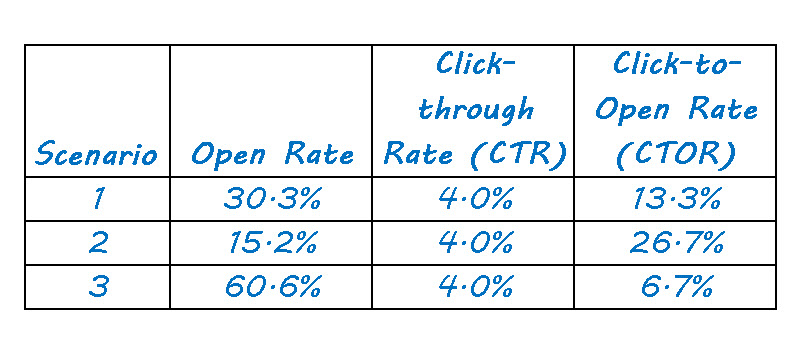“CTR or CTOR: which do you look at? ” was a question on one of the email marketing discussion boards recently. IMHO, here’s the definitive answer.
For those new to email, CTR is click-through rate; it’s calculated by dividing the number of unique (unique meaning one per recipient) clicks divided by the non-bounce send quantity (quantity sent minus bounces). Here’s the written formula:

Click-to-Open Rate is the CTOR metric referenced here. It is calculated by dividing the number of unique clicks by the number of unique opens. Once again, the written formula appears below.

A word of caution: some marketing automation solutions mistakenly calculate CTOR but refer to it as click-through rate or click rate. It’s a good idea to confirm the calculation behind any metric your platform provides, just so you know what you’re dealing with.
So CTR or CTOR? Which should you look at?
The answer is both. There’s no need to choose just one. These two metrics give insight into two very different things, and so it’s useful to look at both. But CTR should always be the first metric you look at; it’s the most valuable.
CTR was one of the first email marketing metrics available. It was around before open rate. Which is why CTR is calculated as it is; there was no ability to track opens when CTR was invented.
CTR gives you a good read on how interested your recipients are in your message. That’s pretty much all your recipients — everyone that you sent the email to minus those that bounced.
Let’s keep the math simple. If you send to 100,000 people, and 1,000 of them bounce, your CTR denominator is 99,000. If 4,000 unique people click on a link in your message, that’s a CTR of 4.0% (4,000/99.000). We know that 4.0% of the people we sent to clicked on our message. Let’s call this pretty good, since the latest Q2 2019 Epsilon Email Trends and Benchmarks Reports put average CTR at 2.9%.
Now let’s kick-around some possibilities for CTOR calculations on the same message.
In CTOR scenario 1, let’s stay that 30,000 unique people opened the email (that would give us an open rate of 30.3%, which is close to the latest open rate average in the same Epsilon report referenced above). Keeping the same 4,000 unique people clicking, that’s a CTOR of 13.3% (4,000/30,000). This tells us that 13.3% of those who opened the email also clicked on a link.
Now let’s develop a scenario 2. In this one, let’s cut the number of unique openers in half, to 15,000 (15.2% open rate). Assuming the same 4,000 people clicked, that’s a CTOR of 26.7% (4,000/15,000).
And let’s look at a third scenario, where we had 60,000 unique people open the email (60.6% open rate), with the same 4,000 unique clicks. That’s a CTOR of 6.7% (4,000/60,000).
Now let’s look at the metrics side-by-side.

Typically email marketers are looking to drive traffic to a website, which means clicks. This is the starting point to getting to the conversion, as those who don’t go to the site are much less likely to covert.
As you can see from the CTR, all three scenarios drove the exact same amount of web traffic. 4,000 people, or 4.0% of the 99,000 we sent to, visited the website. CTR makes that very clear.
When you only look at CTOR, you’re not getting a true picture of what’s going on. It looks like scenario 2 did the best job of driving traffic to the site, followed by scenario 1, with scenario 3 bringing up the rear. Which is not true; all scenarios delivered the same amount of traffic to the site. That’s why CTOR should never replace CTR as your key click metric.
But CTOR is valuable. While it doesn’t go to the overall success or failure of your email’s ability to drive traffic to a website, it does provide a ‘clean read’ on how well the body of an email message did at driving traffic, adjusting for differences in open rate.
That makes CTOR is a good secondary metric. But it doesn’t and never will replace CTR as your primary click metric.
Try this type of CTR vs. CTOR analysis with your next campaign and let me know if you agree.






